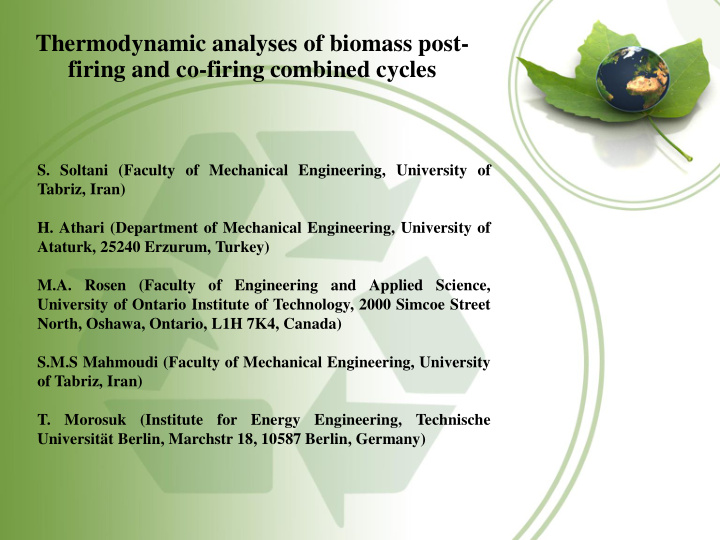



Thermodynamic analyses of biomass post- firing and co-firing combined cycles S. Soltani (Faculty of Mechanical Engineering, University of Tabriz, Iran) H. Athari (Department of Mechanical Engineering, University of Ataturk, 25240 Erzurum, Turkey) M.A. Rosen (Faculty of Engineering and Applied Science, University of Ontario Institute of Technology, 2000 Simcoe Street North, Oshawa, Ontario, L1H 7K4, Canada) S.M.S Mahmoudi (Faculty of Mechanical Engineering, University of Tabriz, Iran) T. Morosuk (Institute for Energy Engineering, Technische Universität Berlin, Marchstr 18, 10587 Berlin, Germany)
Outline 1. Introduction and literature review 2. System Description 3. Thermodynamic Modeling 4. Results and Discussions 5. Conclusions 2
1. Introduction The possibility / likelihood of global warming is disturbing … … but there may be a bigger problem! 3
1. Introduction Consumption of Energy Increased by 85% Between 1970 and 1999 Quadrillion Btu 700 Projections History 600 500 400 300 200 100 0 1970 1975 1980 1985 1990 1995 1999 2005 2010 2015 2020 By 2020, Consumption will Triple 4
1. Introduction What is biomass • Biomass is a renewable energy source that is derived from living or recently living organisms. • Biomass includes biological material, not organic material like coal. • Energy derived from biomass is mostly used to generate electricity or to produce heat. • Biomass can be chemically and biochemically treated to convert it to a energy-rich fuel. 5
1. Introduction What makes it green (ideally)? • CO 2 emissions/per energy produced is similar to petroleum. • However, CO 2 released is recaptured by next years crops. So, there is no net CO 2 added. 6
1. Introduction 7
1. Introduction 8
1. Introduction What is Biomass Gasification? Basic Process Chemistry • Conversion of solid fuels into combustible gas mixture called producer gas (CO + H 2 + CH 4 ) • Involves partial combustion of biomass • Four distinct process in the gasifier viz. • Drying • Pyrolysis • Combustion • Reduction 9
1. Introduction W HY GASIFICATION 10
1. Literature review Biomass gasification and influence of different gasification parameters on the gasification Thermodynamic analysis of gasification process Power producing systems integrated with gasifiers 11
1. Literature review Influential parameters have been investigated : Humidity of biomass Equivalence ratio Temperature Biomass type Biomass size Pressure Gasification medium 12
2. System Description 10 MW 13 Externally fired combined cycle
2. System Description 10 MW 14 Biomass integrated co-fired combined cycle
2. System Description 10 MW 15 Biomass integrated post-firing combined cycle
3. Thermodynamic Modeling 16
3. Thermodynamic Modeling Present Experiment Zainal equilibrium model Constituent model Hydrogen 18.01 15.23 21.06 Carbon monoxide 18.77 23.04 19.61 Methane 0.68 1.58 0.64 Carbon dioxide 13.84 16.42 12.01 Nitrogen 48.7 42.31 46.68 Oxygen 0.00 1.42 0.00 17
3. Thermodynamic Modeling Thermodynamics • The First Law – The energy of the universe is constant • The Second Law – The Entropy of the universe is constantly increasing. 18
= 3. Thermodynamic Modeling Energy-based methods are not suitable for answering some questions because the only thermodynamic inefficiencies identified by energy-based methods are the transfer of energy to the environment. However, the inefficiencies caused by the irreversibilities within the system being considered are, in general, by far the most important thermodynamic inefficiencies and are identifiable with the aid of an exergetic analysis. Exergy-based methods reveal the location, the magnitude and the sources of inefficiencies and costs impact and allow us to study the interconnections between them. 19
= 3. Thermodynamic Modeling 20
= 3. Thermodynamic Modeling 21
= 3. Thermodynamic Modeling W net, cycle η m LHV fuel fuel W ε= E net,cycle in,cycle 22
4. Results and discussions 23
4. Results and discussions 24
4. Results and discussions 25
4. Results and discussions 26
4. Results and discussions 27
4. Results and discussions 28
4. Results and discussions 1 0.9 0.8 0.7 Exergy efficiency 0.6 0.5 EFCC 0.4 BICFCC 0.3 BIPFCC 0.2 0.1 0 29
5. Conclusion The BIPFCC energy efficiency is about 3% and 6% points higher than those of the BICFCC and EFCC, respectively. Correspondingly, the exergy loss in BIPFCC is lower relative to the BICFCC and EFCC. The energy and exergy efficiencies of the three biomass fired configurations are maximized at particular values of compressor pressure ratio, and increasing the TIT raises the energy and exergy efficiencies for the BIPFCC, EFCC and BICFCC. The mass of air per mass of steam is highest for the BIPFCC, but increasing the pressure ratio reduces this value for the BIPFCC and increases it slightly for the BICFCC and EFCC. Increasing TIT raises the mass of air per mass of steam for the BIPFCC and decreases it slightly for the other cycles. 30
5. Conclusion The exergy efficiencies for the components of the three configurations, determined for the maximum energy efficiency condition, indicate that the gas turbine exergy efficiency is the highest for three configurations, the BIPFCC exhibits the highest gas turbine exergy efficiency, the BICFCC combustion chamber has the highest exergy efficiency, and the lowest exergy efficiency is for the BIPFCC. The post combustion chamber of the BICFCC exhibits the highest exergy efficiency, while the heat exchanger exergy efficiency is highest for the EFCC. 31
5. Conclusion The efficiencies of biomass plants are comparatively low, but their availability, renewability and environmental characteristics can justify their use. The results may prove beneficial for designers and engineers of such systems. 32
Many thanks for your attention
Recommend
More recommend